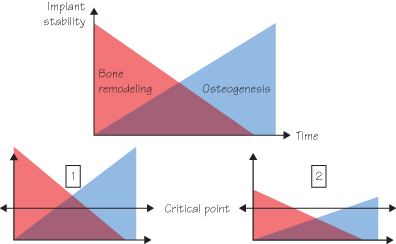25
Treatment planning: immediate, early, and delayed loading
The conventional protocol in dental implant therapy includes a healing period of 2–6 months during which dental implants are unloaded. Nowadays, this period may be shortened or eliminated.
Rationale
After implant insertion, primary initial stability decreases during the first weeks (bone remodeling), while secondary stability (osteogenesis) increases during the same period (Fig. 25.1). The role of forces transmitted to the implant during this period is not clear: implant micromotion, if excessive, can affect osteogenesis and impair osseointegration, but it seems that limited loading may not be detrimental and may even be beneficial. If micromotion is kept under a threshold of about 150 µm during the entire healing process, osseointegration will occur normally. During this period, the control of factors influencing bone remodeling, osteogenesis, and micromotion is the biological basis of immediate loading.
Figure 25.1 Evolution of dental implant stability in time, after surgical placement. 1. Favorable conditions for immediate loading: good primary stability and rapid osteogenesis. 2. Unfavorable conditions for immediate loading: insufficient primary stability and slow osteogenesis.

Definitions

Loading is defined as full occlusal contact at least in centric occlusion. Immediate restoration (syn: non-occlusal loading) means that despite no occlusal contact, some forces are transmitted to the implants by muscles (tongue, lips, cheeks) and food.
Background
Until a few years ago, predictable results with immediate and early loading protocols were only described in the anterior mandible area. Today, more data are available for edentulous maxilla, fixed partial dentures, and single-tooth implants.
Although immediate and early loading protocols are viable treatment options, the evidence level is low, and very often clinical studies are characterized by high patient selection and trained operators, both minimizing the risk. From a scientific point of view, the more predictable option is still the conventional approach, followed by immediate loading, and finally, the early loading approach (E/>
Stay updated, free dental videos. Join our Telegram channel

VIDEdental - Online dental courses


